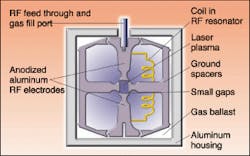The most popular image of a laser is that of a powerful cutting beam, capable of burning through steel. For almost 40 years the carbon dioxide (CO2) laser has come closest to matching this image. Large CO2 lasers can cut steel several inches thick without utilizing all of their power capability. Smaller units, still capable of hundreds of watts of average pulsed or continuous wave (cw) output, are widely used as directed thermal sources to remove material in medical and industrial uses.
From basic principles
The invention of the carbon dioxide laser in 1964 by Kumar Patel at Bell Labs was the result of his fundamental investigation of gas laser efficiency. Electronic transitions in gases generally have their first excited level high above the ground state, resulting in inherently inefficient energy conversion. Patel reasoned that the vibrational levels of molecular gases could provide a much more efficient laser medium. These energy levels relate to the motion of the atomic constituents of the molecule—the electrons are not directly involved.
Patel chose to work with carbon dioxide, which requires only about 1/3 eV to excite the upper laser levelcompare this to almost 20 eV for a HeNe laser. He expected to find laser oscillation around 10 µm, and his device worked the first time it was tried. By adding nitrogen, Patel immediately boosted the output of the laser to 10 W, a 1000-fold increase.
Nitrogen has a very long-lived first-excited vibrational state that almost exactly matches the upper level of CO2, and the process of transferring this energy to carbon dioxide is very efficient. Helium was added next to help empty the lower level and transfer heat to the tube walls. Since the laser levels are so close to the ground state, as the CO2 heats up the lower laser levels are thermally populated, so the laser should be kept below 150°C. A ratio of 1:2:3 for the CO2:N2:He mix is typical. The result is a gas laser with a wall-plug efficiency that can be around 30%.
In studying his new laser, Patel realized it was only necessary to achieve inversion between rotational states of vibrational bands, not between the vibrational states themselves (see Fig. 1). He had discounted diatomic gases because they have only one family of vibrational levels that decreases in lifetime with increasing energy, which does not in itself permit population inversion. Patel revisited diatomic carbon monoxide and discovered an important laser transition at 5 µm.Carbon dioxide dissociates during operation of the laser. The oxygen produced will attack tube components and kill a sealed laser in minutes without safeguards. The oxygen can be "gettered," or other gases can be added to combine with the dissociated gases. According to Cathy McBeth-Schomber, marketing manager for Synrad, "A sealed CO2 laser will operate in excess of 35,000 continuous operating hours before a gas refill is required."
A steady advance
While the fundamental technology has remained unchanged, engineering advances have enabled manufacturers to offer significantly improved products in the low power category (<500 W). Starting in the 1980s, pumping by RF excitation gained acceptance (see Fig. 2). A larger volume of the gas can be excited by RF than by a discharge, resulting in smaller lasers for a given output level.Radio frequency pumping also allows greater control of pulsed output. An entire complex pulse train can be programmed to optimize material processing. All-metal tubes for RF (without expensive ceramics) offset the increased cost of the RF supply, while advances in RF transistors over the past few years have resulted in smaller and less expensive supplies. Sealed air-cooled CO2 lasers of up to 100 W output are now available with RF supplies integrated onto the laser head, resulting in a much more compact package.
Process efficiency is also improved by better beam quality, which can result in higher manufacturing throughput. These advances have resulted largely from improvements to CO2 optics, which use materials including zinc selenide (ZnSe), gallium arsenide (GaAs), and germanium (Ge) for lenses, and gold or silver on silicon substrate for mirrors. These improvements have resulted in sealed CO2 lasers that now routinely offer beams with M2 <1.5.
Taken together, high-quality beams and shaped pulse trains can double or even triple effective power, so modern 500-W CO2 lasers can perform tasks that formerly required at least a 1 kW laser. A smaller laser means easier integration into systems, and a smaller footprint on the factory floor. Air cooling is simpler and more flexible than the water-cooling alternative. Mcbeth states, "As far as the future of the technology of these products, I think the main trend will be to produce smaller, more efficient lasers."
Historically the CO2 laser has been the scalpel of choice for many surgical procedures that take place within a cavity of the body. The 10-µm output is absorbed quickly by water in flesh, creating superheated steam that vaporizes the enclosing tissue. The cut width can be very fine, with a beneficial cauterizing effect. Recent growth in medical applications, however, has been in applications in which other types of lasers are more suited.
One exception to this trend is skin resurfacing, a cosmetic procedure that has been gaining popularity. Severe acne and other skin texture imperfections can be smoothed and rejuvenated using a pulsed CO2 laser. Pulse duration and energy level relate directly to the amount of thermal damage to peripheral tissue. If the pulse duration is too long, inadvertent damage can cause prolonged erythema (a sunburn-like condition). Sufficient relaxation time between pulses is required to allow the skin to recover.
A little piece of the heart
A more vital medical use for the CO2 laser is for transmyocardial revascularization, or TMR, which is a treatment for angina, the basic symptom of coronary artery disease. Angina is chest pain caused by lack of oxygen to the heart. Standard surgical procedures such as coronary bypass or balloon angioplasty often fail to relieve angina, or perhaps cannot be performed due to the patient's poor health, leaving the victim with debilitating pain and shortness of breath. Though not a cure, TMR usually provides angina sufferers relief from pain.
In TMR, a pulsed CO2 laser makes 25 to 45 holes one millimeter in diameter through the wall of the heart. The holes are spaced about a centimeter apart in the left ventricle, the lower chamber of the heart that pumps oxygen-rich blood to the body (see diagram, p. 185). As much as 60-J of energy is required for a heart with a high level of fat. The surgeon then massages the perforated area with a gloved finger to stimulate coagulation to seal the outside of the holes.
A major concern is to confine the tissue ablation to the targeted areas. The laser pulses therefore must be synchronized to fire during systole, the phase of the heart beat when the muscle thickens as it pumps.
This procedure is still relatively new and it is not yet understood how TMR works—possibly, as the name implies, it stimulates the natural growth of new blood vessels in the heart wall, or perhaps it simply deadens nerves in the affected muscle. The acceptance of TMR has been slowed by complications for some patients, including the return of angina and low blood pressure. Overall the clinical results have been encouraging, and TMR has received FDA approval.
Light for industry
In most commercial applications, the CO2 laser is a directed thermal source for cutting, drilling, and other processes that ablate material. Absorption of CO2 wavelengths matches best with nonmetals. However because of its high average power, the laser is still commonly used to cut and weld steel and other less-reflective metals.
There are two thresholds to cut any material—the energy required to simply cut through the material, and the energy required to cut it well, with edges that are square, with roughness measured in microns, and little or no burring. Metal cutting is best performed at pulse repetition rates of 1 to 2 kHz. Modern CO2 lasers capable of repetition rates up to 100 kHz are used for cutting nonmetals or for welding thin sheets of steel.
In addition to the properties of the material itself, other considerations include the interaction of the beam with the vapors produced in the process, the size of cut relative to the size of the focused beam, and, in some instances, the polarization of the beam.
Carbon dioxide laser manufacturers often enjoy a significant lower-cost advantage over other technologies. For the most part, other lasers do not compete with low-power CO2 systems, with the exception of those based on Nd:YAG, which are more commonly used for metal marking because of their higher peak power. The past several years have seen an increase in marking applications, as product identification and traceability have become increasingly important. Much of this growth has been in the marking of glass, quartz, and ceramics with two-dimensional bar codes or serial numbers for electronic parts.
The 9.4-µm output is used to process some materials that exhibit higher absorption than for the 10.6-µm output, such as certain plastics, and this application has also seen substantial growth.
About the Author
Stephen J. Matthews
Contributing Editor
Stephen J. Matthews was a Contributing Editor for Laser Focus World.


